Nuclear Power in the World Today
(Updated May 2023)
- The first commercial nuclear power stations started operation in the 1950s.
- Nuclear energy now provides about 10% of the world's electricity from about 440 power reactors.
- Nuclear is the world's second largest source of low-carbon power (26% of the total in 2020).
- Over 50 countries utilize nuclear energy in about 220 research reactors. In addition to research, these reactors are used for the production of medical and industrial isotopes, as well as for training.
Nuclear technology uses the energy released by splitting the atoms of certain elements. It was first developed in the 1940s, and during the Second World War research initially focused on producing bombs. In the 1950s attention turned to the peaceful use of nuclear fission, controlling it for power generation. For more information, see page on History of Nuclear Energy.
Civil nuclear power can now boast more than 18,000 reactor years of experience, and nuclear power plants are operational in 32 countries worldwide. In fact, through regional transmission grids, many more countries depend in part on nuclear-generated power; Italy and Denmark, for example, get almost 10% of their electricity from imported nuclear power.
When the commercial nuclear industry began in the 1960s, there were clear boundaries between the industries of the East and West. Today, the nuclear industry is characterized by international commerce. A reactor under construction in Asia today may have components supplied from South Korea, Canada, Japan, France, Germany, Russia, and other countries. Similarly, uranium from Australia or Namibia may end up in a reactor in the UAE, having been converted in France, enriched in the Netherlands, deconverted in the UK and fabricated in South Korea.
The uses of nuclear technology extend well beyond the provision of low-carbon energy. It helps control the spread of disease, assists doctors in their diagnosis and treatment of patients, and powers our most ambitious missions to explore space. These varied uses position nuclear technologies at the heart of the world's efforts to achieve sustainable development. For more information, see page on Nuclear Energy and Sustainable Development.
In 2021 nuclear plants supplied 2653 TWh of electricity, up from 2553 TWh in 2020.
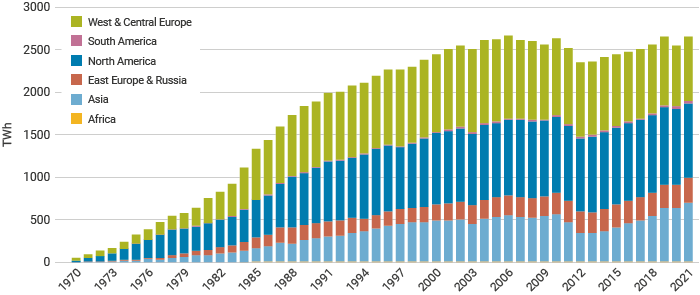
Figure 1: Nuclear electricity production (source: World Nuclear Association, IAEA PRIS)
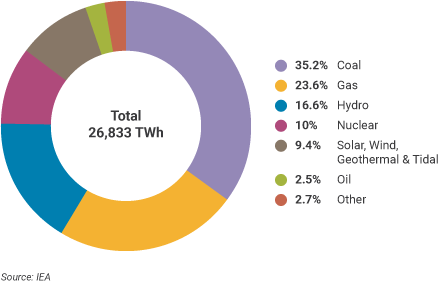
Figure 2: World electricity production by source 2020 (source: International Energy Agency)
Thirteen countries in 2021 produced at least one-quarter of their electricity from nuclear. France gets up to around 70% of its electricity from nuclear energy, while Ukraine, Slovakia, Belgium and Hungary get about half from nuclear. Japan was used to relying on nuclear power for more than one-quarter of its electricity and is expected to return to somewhere near that level.
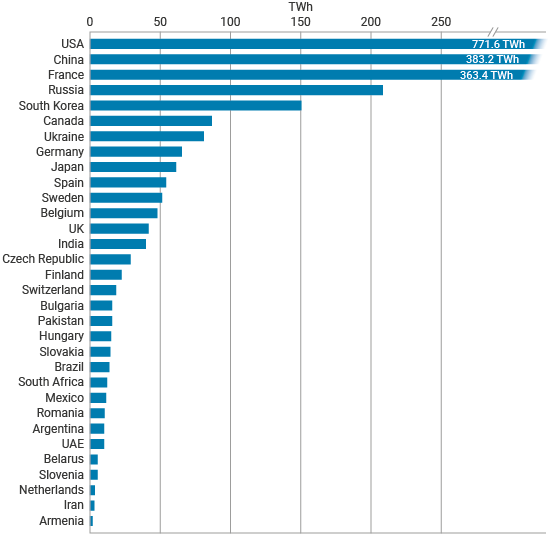
Figure 3: Nuclear generation by country 2021 (source: IAEA PRIS)
Developments in 2023
Grid connections
Construction starts
Reactor shutdowns
Need for new generating capacity
There is a clear need for new generating capacity around the world, both to replace old fossil fuel units, especially coal-fired ones, which emit a lot of carbon dioxide, and to meet increased demand for electricity in many countries. In 2020, 61% of electricity was generated from the burning of fossil fuels. Despite the strong support for, and growth in, intermittent renewable electricity sources in recent years, the fossil fuel contribution to power generation has not changed significantly in the last 15 years or so (66.5% in 2005).
The OECD International Energy Agency publishes annual scenarios related to energy. In its World Energy Outlook 20221 there is an ambitious ‘Net Zero Emissions by 2050 Scenario' (NZE), which "maps out a way to achieve a 1.5°C stablisation in the rise in global average temperatures, alongside universal access to modern energy by 2030." The NZE in WEO 2022 sees nuclear capacity increase to 871 GWe by 2050.
World overview
All parts of the world are involved in nuclear power development, and some examples are outlined below.
For up-to-date data on operable, under construction and planned reactors worldwide, see table of World Nuclear Power Reactors & Uranium Requirements.
For detailed country-level information, see the Country Profiles section of World Nuclear Association's Information Library.
North America
Canada has 19 operable nuclear reactors, with a combined net capacity of 13.6 GWe. In 2021, nuclear generated 14.3% of the country's electricity.
All but one of the country's 19 nuclear reactors are sited in Ontario. Ten of those units – six at Bruce and four at Darlington – are to undergo refurbishment. The programme will extend the operating lifetimes by 30-35 years. Similar refurbishment work enabled Ontario to phase out coal in 2014, achieving one of the cleanest electricity mixes in the world.
Mexico has two operable nuclear reactors, with a combined net capacity of 1.6 GWe. In 2021, nuclear generated 5.3% of the country's electricity.
The USA has 93 operable nuclear reactors, with a combined net capacity of 95.8 GWe. In 2021, nuclear generated 19.6% of the country's electricity.
There had been four AP1000 reactors under construction, but two of these have been cancelled. One of the reasons for the hiatus in new build in the USA to date has been the extremely successful evolution in maintenance strategies. Over the last 15 years, improved operational performance has increased utilisation of US nuclear power plants, with the increased output equivalent to 19 new 1000 MWe plants being built.
2016 saw the first new nuclear power reactor enter operation in the country for 20 years. Despite this, the number of operable reactors has reduced in recent years, from a peak of 104 in 2012. Early closures have been brought on by a combination of factors including cheap natural gas, market liberalization, over-subsidy of renewable sources, and political campaigning.
South America
Argentina has three reactors, with a combined net capacity of 1.6 GWe. In 2021, the country generated 7.2% of its electricity from nuclear.
Brazil has two reactors, with a combined net capacity of 1.9 GWe. In 2021, nuclear generated 2.4% of the country's electricity.
West & Central Europe
Belgium has seven operable nuclear reactors, with a combined net capacity of 5.9 GWe. In 2021, nuclear generated 50.8% of the country's electricity.
Finland has five operable nuclear reactors, with a combined net capacity of 4.4 GWe. In 2021, nuclear generated 32.8% of the country's electricity. Finland's fifth reactor – a 1600 MWe (net) EPR – was connected to the grid in March 2022.
France has 56 operable nuclear reactors, with a combined net capacity of 61.4 GWe. In 2021, nuclear generated 69.0% of the country's electricity.
A 2015 energy policy had aimed to reduce the country's share of nuclear generation to 50% by 2025. This target has now been postponed to 2035. The country's energy minister said that the target was not realistic, and that it would increase the country's carbon dioxide emissions, endanger security of supply and put jobs at risk.
One reactor is currently under construction in France – a 1750 MWe EPR at Flamanville.
The Netherlands has a single operable nuclear reactor, with a net capacity of 0.5 GWe. In 2021, nuclear generated 3.1% of the country's electricity.
Spain has seven operable nuclear reactors, with a combined net capacity of 7.1 GWe. In 2021, nuclear generated 20.8% of the country's electricity.
Sweden has six operable nuclear reactors, with a combined net capacity of 6.9 GWe. In 2021, nuclear generated 30.8% of the country's electricity.
The country is closing down some older reactors, but has invested heavily in operating lifetime extensions and uprates.
Switzerland has four operable nuclear reactors, with a combined net capacity of 3.0 GWe. In 2021, nuclear generated 28.8% of the country's electricity.
The United Kingdom has 9 operable nuclear reactors, with a combined net capacity of 5.9 GWe. In 2021, nuclear generated 14.8% of the country's electricity.
A UK government energy paper in mid-2006 endorsed the replacement of the country’s ageing fleet of nuclear reactors with new nuclear build. Construction has commenced on the first of a new-generation of plants.
Central and East Europe, Russia
Armenia has a single nuclear power reactor with a net capacity of 0.4 GWe. In 2021, nuclear generated 25.3% of the country's electricity.
Belarus has two operable nuclear power reactors, with a combined net capacity of 2.2 GWe. Almost all the rest of the country's electricity is produced from natural gas. In 2021, nuclear generated 14.1% of the country's electricity.
Bulgaria has two operable nuclear reactors, with a combined net capacity of 2.0 GWe. In 2021, nuclear generated 34.6% of the country's electricity.
The Czech Republic has six operable nuclear reactors, with a combined net capacity of 3.9 GWe. In 2021, nuclear generated 36.6% of the country's electricity.
Hungary has four operable nuclear reactors, with a combined net capacity of 1.9 GWe. In 2021, nuclear generated 46.8% of the country's electricity.
Romania has two operable nuclear reactors, with a combined net capacity of 1.3 GWe. In 2021, nuclear generated 18.5% of the country's electricity.
Russia has 37 operable nuclear reactors, with a combined net capacity of 27.7 GWe. In 2021, nuclear generated 20.0% of the country's electricity.
A government decree in 2016 specified construction of 11 nuclear power reactors by 2030, in addition to those already under construction. At the start of 2022, Russia had three reactors under construction, with a combined capacity of 2.6 GWe.
The strength of Russia's nuclear industry is reflected in its dominance of export markets for new reactors. The country's national nuclear industry is currently involved in new reactor projects in Belarus, China, Hungary, India, Iran and Turkey, and to varying degrees as an investor in Algeria, Bangladesh, Bolivia, Indonesia, Jordan, Kazakhstan, Nigeria, South Africa, Tajikistan and Uzbekistan among others.
Slovakia has four operable nuclear reactors, with a combined net capacity of 1.8 GWe. In 2021, nuclear generated 52.3% of the country's electricity. A further two units are under construction.
Slovenia has a single operable nuclear reactor with a net capacity of 0.7 GWe. In 2021, Slovenia generated 36.9% its electricity from nuclear.
Ukraine has 15 operable nuclear reactors, with a combined net capacity of 13.1 GWe. In 2021, nuclear generated 55.0% of the country's electricity.
Turkey commenced construction of its first nuclear power plant in April 2018, with start of operation expected in 2023.
Asia
Bangladesh started construction on the first of two planned Russian VVER-1200 reactors in 2017. Construction on the second started in 2018. It plans to have the first unit in operation by 2023. The country currently produces virtually all of its electricity from fossil fuels.
China has 55 operable nuclear reactors, with a combined net capacity of 53.3 GWe. In 2021, nuclear generated 5.0% of the country's electricity.
The country continues to dominate the market for new nuclear build, with 21 reactors under construction at the end of July 2022. In 2018 China became the first country to commission two new designs – the AP1000 and the EPR. China is marketing the Hualong One for export, a largely indigenous reactor design.
The strong impetus for developing new nuclear power in China comes from the need to improve urban air quality and reduce greenhouse gas emissions.
India has 22 operable nuclear reactors, with a combined net capacity of 6.8 GWe. In 2021, nuclear generated 3.2% of the country's electricity.
The Indian government is committed to growing its nuclear power capacity as part of its massive infrastructure development programme. The government in 2010 set an ambitious target to have 14.6 GWe nuclear capacity online by 2024. At the end of July 2022 eight reactors were under construction in India, with a combined capacity of 6.7 GWe.
Japan has 33 operable nuclear reactors, with a combined net capacity of 31.7 GWe. As of March 2022, 10 reactors had been brought back online, with a further 15 in the process of restart approval, following the Fukushima accident in 2011. In the past, 30% of the country's electricity has come from nuclear; in 2021, the figure was just 7.2%.
South Korea has 25 operable nuclear reactors, with a combined net capacity of 24.4 GWe. In 2021, nuclear generated 28.0% of the country's electricity.
The country has three new reactors under construction domestically and is constructing a four-unit plant in the United Arab Emirates.
Pakistan has six operable nuclear reactors, with a combined net capacity of 3.3 GWe. In 2021, nuclear generated 10.6% of the country's electricity. Pakistan has one Chinese Hualong One unit under construction, which achieved first criticality in February 2022.
Africa
Egypt started construction in July 2022 of the first of four Russian-designed VVER units to be built at the El Dabaa site on the Mediterranean coast. The second unit began construction in November 2022. All four reactors are expected to be operational by 2030.
South Africa has two operable nuclear reactors, with a combined net capacity of 1.9 GWe, and is the only African country currently producing electricity from nuclear. In 2021, nuclear generated 6.0% of the country's electricity. South Africa remains committed to plans for further capacity, but financing constraints are significant.
Middle East
Iran has a single operable nuclear reactor with a net capacity of 0.9 GWe. In 2021, nuclear generated 1.0% of the country's electricity. A second Russian-designed VVER-1000 unit is under construction.
The United Arab Emirates has three operable nuclear reactors with a capacity of 4.0 GWe. A fourth unit is under construction at the same plant (Barakah). In 2021, nuclear generated 1.3% of the country's electricity.
Emerging nuclear energy countries
As outlined above, Bangladesh, Turkey and the United Arab Emirates are all constructing their first nuclear power plants. A number of other countries are moving towards use of nuclear energy for power production. For more information, see page on Emerging Nuclear Energy Countries.
Improved performance from existing reactors
The performance of nuclear reactors has improved substantially over time. Over the last 40 years the proportion of reactors reaching high capacity factors has increased significantly. For example, 68% of reactors achieved a capacity factor higher than 80% in 2021, compared to less than 30% in the 1970s, whereas only 6% of reactors had a capacity factor lower than 50% in 2021, compared to just over 20% in the 1970s.
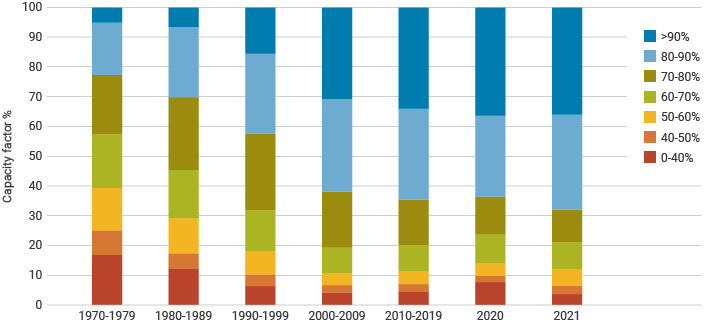
Figure 4: Long-term trends in capacity factors (source: World Nuclear Association, IAEA PRIS)
It is also notable that there is no significant age-related trend in the mean capacity factor for reactors over the last five years.
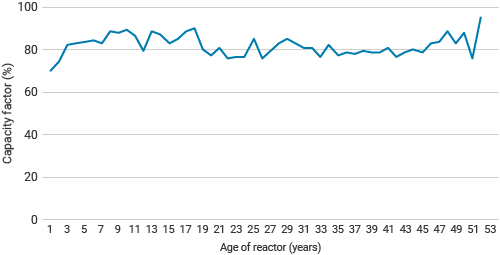
Figure 5: Mean capacity factor 2017-2021 by age of reactor (source: World Nuclear Association, IAEA PRIS)
Other nuclear reactors
In addition to commercial nuclear power plants, there are about 220 research reactors operating in over 50 countries, with more under construction. As well as being used for research and training, many of these reactors produce medical and industrial isotopes.
The use of reactors for marine propulsion is mostly confined to the major navies where it has played an important role for five decades, providing power for submarines and large surface vessels. Over 160 ships, mostly submarines, are propelled by some 200 nuclear reactors and over 13,000 reactor years of experience have been gained with marine reactors. Russia and the USA have decommissioned many of their nuclear submarines from the Cold War era.
Russia also operates a fleet of large nuclear-powered icebreakers and has more under construction. It has also connected a floating nuclear power plant with two 32 MWe reactors to the grid in the remote arctic region of Pevek. The reactors are adapted from those powering icebreakers.
For more information see page on The Many Uses of Nuclear Technology.
Notes & references
References
1. OECD International Energy Agency, World Energy Outlook 2022 [Back]
2. OECD International Energy Agency Statistics [Back]
General references
World Nuclear Association, World Nuclear Performance Report 2022